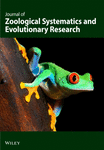New approaches to a better understanding of nematode phylogeny: molecular and developmental studies*
Presented at the Phylogenetic Symposium in Vienna/Austria from 19th to 21st November 1999.
Abstract
Recent studies making use of ribosomal DNA sequences have led to a wealth of new information that can be used to construct phylogenetic trees and compare them with those derived from more traditional approaches. Here, some examples are presented where the molecular data have stimulated alternative views. To determine whether differences in developmental processes can be used as markers for intraphyletic relationships, comparative studies of nematode embryogenesis have been performed. These results indicate that considerable deviations from the standard pattern found in the model system Caenorhabditis elegans exist which appear to be characteristic for certain subgroups within the taxon Nematoda.




